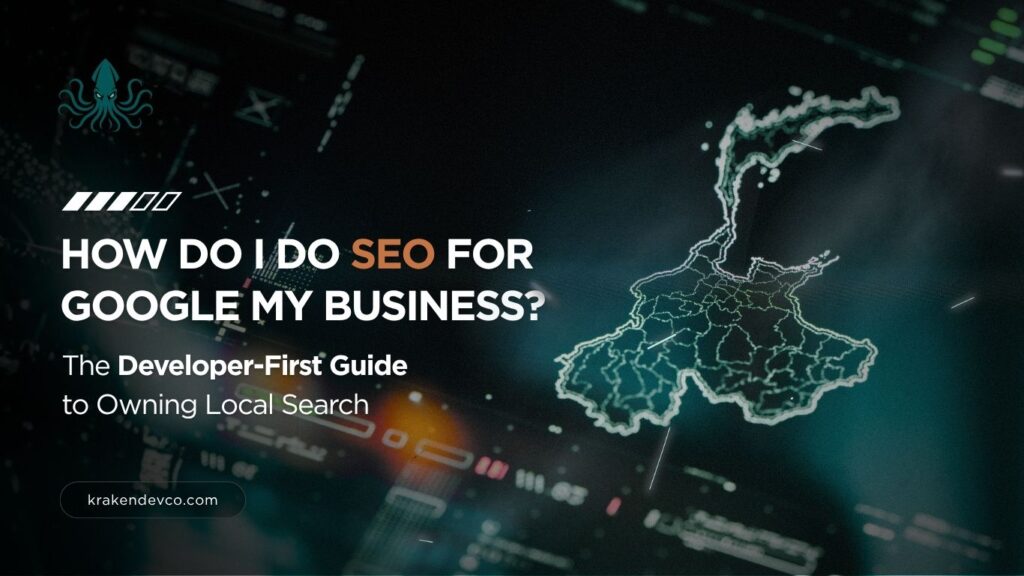
The Developer-First Guide to Owning Local Search
If you’re not showing up on Google Maps, you’re invisible. Local SEO isn’t a checkbox—it’s core infrastructure. Your Google Business Profile (GBP) isn’t just a digital listing. It’s your strongest tool for capturing organic traffic, driving qualified leads, and outclassing the competition in local search rankings.
At Kraken Dev Co, we don’t chase traffic. We build systems that command it.
Why Google My Business SEO Isn’t Optional
Whether you’re in real estate, dental, automotive, or service industries, your Google Business Profile powers your visibility on Google Search, Google Maps, and across Google’s entire ecosystem. Without an optimised GBP, your chances of showing up for relevant searches near you drop to zero.
This isn’t branding. It’s Search Engine Optimisation architecture. It’s what makes your business listing show up when someone searches “emergency plumber near me” or “reliable vet in Glasgow”.
The Three Core Ranking Signals: What Google Looks For
Before we talk tactics, understand how Google’s local algorithm works. Your visibility depends on:
- Relevance: Does your GBP content answer the search query?
- Distance: How physically close is your location to the user?
- Prominence: How well-known, trusted, and cited is your business online?
You can’t fake proximity. But you can—and must—engineer for relevance and prominence.
Step 1: Fully Build and Verify Your Business Profile
Verification First
Until you verify your Google Business Profile, it won’t be eligible for rankings. Choose postcard, phone, or video verification—just get it done.
Optimise Every Field With SEO Intent
- NAP (Name, Address, Phone): Must match your site and all directories.
- Business description: Write for humans but inject target keywords naturally.
- Primary & secondary categories: Be specific. ‘Personal Injury Solicitor’ beats ‘Legal Services’.
- Business hours: Keep them up-to-date. Include changes during holidays.
- Visual content: Add high-quality, geo-tagged photos and videos of your space, team, services, and results.
Don’t leave any field blank. Every input helps you rank.
Step 2: Target Search Intent With High-Quality Content
Think beyond keywords. Align content with how users actually search. That means:
- Using long-tail keywords based on real queries.
- Structuring GBP services and posts around localised search intent.
- Mapping terms back to categories and offerings.
Keyword research tools help identify exactly what your prospective customers are typing into search engines. Use that data to guide your SEO strategy.
Step 3: Drive Authority With Online Reviews
Google Reviews Directly Impact Your Rankings
Here’s what matters:
- Volume: More = better.
- Recency: Fresh reviews carry more algorithmic weight.
- Sentiment: Positive reviews help, negative reviews hurt.
- Response rate: Reply to every review.
Review Strategy Tactics
- Ask post-service via email marketing flows or manual follow-up.
- Never fake or incentivise reviews. Violates guidelines and can lead to suspension.
- Use smart phrasing: “Thanks for trusting us with your bathroom renovation in Leeds. Could you leave us a review on Google?”
If you want to build trust and increase conversions, start with real feedback.
Step 4: Link Your Website’s SEO With Your GBP
Technical Foundations That Power Rankings
- Site speed: Mobile-first load times under 2 seconds.
- Structured data markup: Use schema markup to describe your business, reviews, and services to search bots.
- Clean URL structure: Avoid query strings. Use regional folders like /locations/manchester.
- Internal links: Build logical connections between local service pages, blog content, and category pages.
This isn’t fluff. These are technical optimisations that make your data parseable and your SEO rankings stable.
Step 5: Build Hyper-Local Landing Pages
One service, one city = one dedicated page. Each local landing page should include:
- An embedded Google Map.
- Matching business address, contact details, and operating hours.
- Regional testimonials and visual content.
- Clear directions or parking instructions.
- Unambiguous, original body content—no duplicate content.
No keyword stuffing. No copying and pasting. Each piece of content should be handcrafted to convert local interest into leads.
Step 6: Scale Off-Page SEO Like a Machine
Your online reputation doesn’t stop at Google.
Build Off-Page Signals:
- Citations: Submit NAP to industry and geographic directories.
- Backlinks: Earn links from external sites like local papers, business partners, and community blogs.
- PR mentions: Media coverage increases search engine visibility and trust.
- Outreach emails: Build relationships that turn into links and authority.
This builds your prominence metric, which Google uses to rank your business.
Step 7: Treat Google Posts Like Micro-Campaigns
Google Posts are content assets. Use them.
- Announce events, promotions, or product updates.
- Include a CTA and structured visual content.
- Optimise with relevant keywords, naturally placed.
- Minimum: one post per week.
Regular updates signal that your business is active, relevant, and trustworthy.
Step 8: Multi-Location? Operationalise It
Running multiple locations? You’ll need tools and processes.
- LocalClarity or Yext for listing management.
- Yoast SEO Premium for structured content on WordPress.
- Google Sheets to track profile accuracy across teams.
- Dedicated review response workflows in your CRM.
Google My Business SEO at scale requires orchestration. Without it, you’re winging it—and that’s how listings get buried.
Step 9: Monitor Performance With Real Data
Data is your diagnostic tool. Use:
- Google Business Profile Insights: Understand profile views, clicks, direction requests, and search types.
- Google Search Console: Track crawl health, search traffic, impressions, and CTR.
- Google Analytics 4: Dive into bounce rate, conversions, and session flow.
Every iteration should be data-driven, not opinion-based.
Step 10: Avoid SEO Penalties
Avoid These Tactics at All Costs:
- Keyword cannibalisation
- Fake reviews
- Broken links
- Category mismatches
- Duplicate listings
- Meta keyword tags
- Low-quality spammy backlinks
Google is watching—and it’s smarter than ever. Clean SEO beats dirty tricks.
Step 11: Align With Google’s Latest SEO Standards
Google’s Search Quality Evaluator Guidelines (2025) demand:
- High-quality content with experience and expertise
- Authentic authorship and transparent sources
- Purpose-driven pages (no keyword-stuffed filler)
- Content built for users, not bots
Kraken Dev Co complies and leads here. No AI junk, no templates, no shortcuts.
Kraken Dev Co’s Local SEO Stack
When Kraken Dev Co takes the helm, here’s what we deploy:
- Fully optimised, verified Google Business Profiles
- Weekly posting and content updates
- Schema-rich, fast local pages
- Citation building and off-page link building
- Review generation pipelines integrated into your CRM
- On-site technical audits (speed, crawlability, internal links)
- Continuous iteration using Search Console and GA4
We don’t make assumptions. We build data-backed systems for maximum visibility.
Final Word: Your Local SEO Is Only as Strong as Your Infrastructure
Search engine optimisation isn’t about traffic—it’s about control.
If your online visibility is unstable, you’re leaving growth to luck. Kraken Dev Co builds infrastructure that owns the map pack, climbs search engine rankings, and delivers measurable revenue from organic search.
Don’t guess. Don’t wait. Let’s engineer your presence from the ground up.
Start your build today → KrakenDevCo.com



